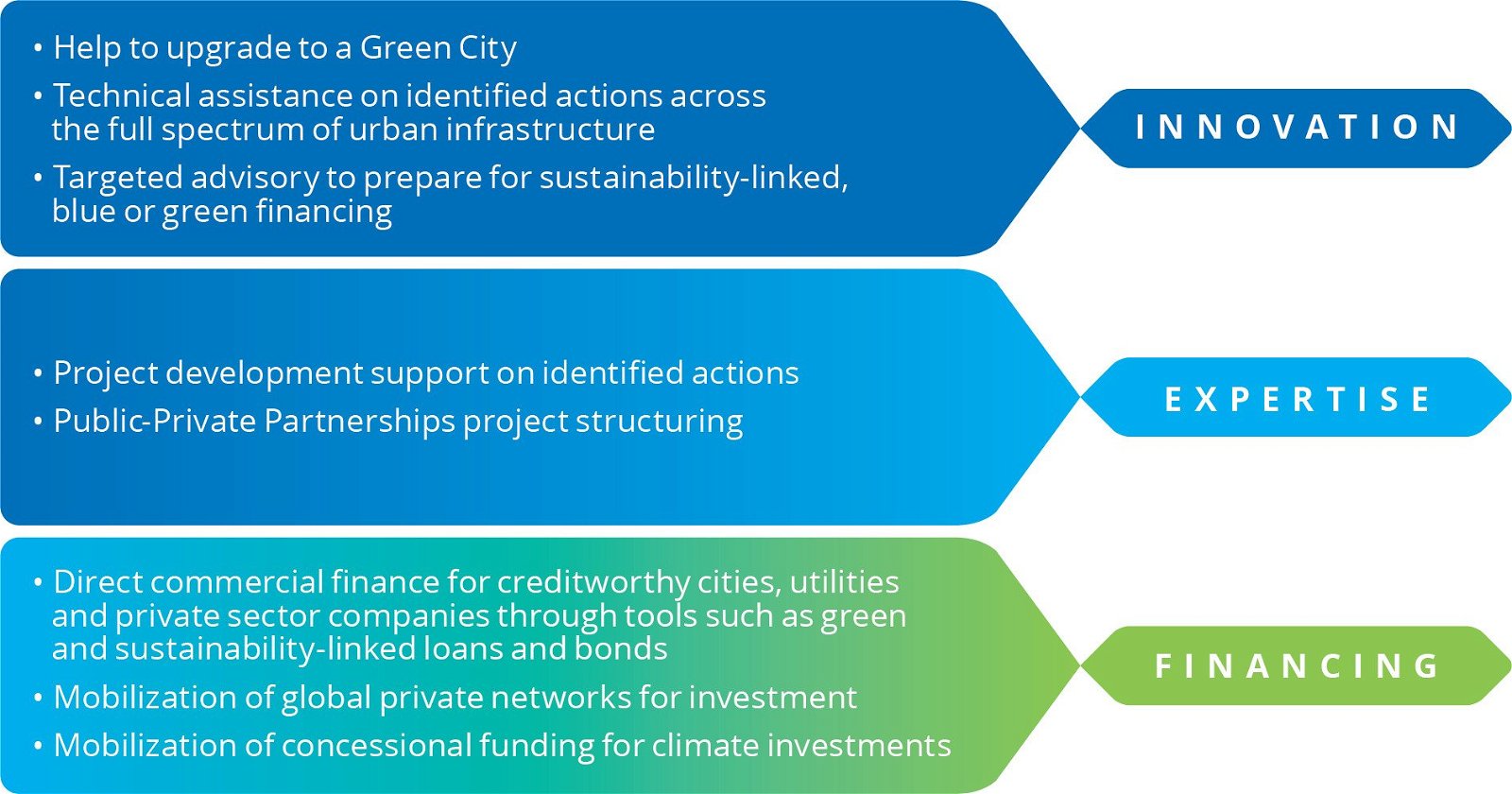How to make your city's climate action plan actually work


· 5 min read
The roadmap to support green recovery, as outlined in a Climate Action Plan (CAP), is one thing. On-the-ground execution is another. This implementation gap must be bridged for successful outcomes – only then are measurable impacts realized on a city’s journey to becoming green.
To implement a CAP successfully, city officials must first tackle three crucial challenges:
Overcoming these challenges is no small feat and these are by no means the only barriers to successfully greening a city through implementing carbon reduction measures. However, the ability to meet the omnipresent challenges of financing, government access to expertise and the right technological tools, as well as fostering positive public opinion can make or break promises delivered in a Green City Action Plan.
Green financing directs money from various public, private and non-profit sources to sustainable development initiatives. It is a key enabler in implementing a Green City Action Plan. By 2030, cities in emerging markets stand to unlock over 29 trillion USD in green finance investment across sectors identified in a CAP (i.e. renewable energy, public transportation, waste management, water security, electric vehicles and green buildings, among others).
Navigating the green financing landscape and leveraging opportunities at scale demand robust public-private partnerships and collaborations with other stakeholders including green financing experts who can recommend funding avenues, help secure funds, and oversee implementation from a regulatory and compliance standpoint.
In this regard, IFC, a member of the World Bank Group, is uniquely positioned to help mayors and municipal leaders meet their cities’ green financing requirements. Through its Cities Initiative – which combines investment and advisory expertise – IFC forges partnerships with cities around the world to meet pressing urban needs with private sector participation.
In fact, one of its recent initiatives, APEX (Advanced Practices for Environmental Excellence) Green Cities, leverages IFC’s multilateral advisory and investment prowess to help mayors and other municipal leaders secure the appropriate expertise and funding to build sustainable, desirable, and climate-resilient cities.
The graphic below demonstrates IFC’s three-pronged approach that helps cities avail a broad range of advisory and investment solutions.
Figure 1. IFC helps cities across a broad range of advisory and investment solutions

With a host of competing priorities, cities often struggle to prioritize the hierarchy of sustainable development initiatives. The priority of greening actions impacts the financial landscape, and it can often be challenging for city officials and sector leads to ascertain which measures should be prioritized, and what financial mechanisms are available that will work optimally for a particular set of measures.
One overarching question is whether cities are utilizing their existing public funds wisely. From the inside, it can be difficult to see the forest through the trees and to properly assess the impacts and costs of sustainability plans. Cities interested in developing a CAP would benefit from a solutions-based assessment tool that identifies investment pathways – including from the private sector – as well as highlights policy initiatives to lubricate green projects.
Enabling policy environments opens doors to a greener future so that a Green City Action Plan can be implemented and have an impact. This includes fostering supportive relationships between national and local governments, as well as strengthening the city’s ability to overcome bureaucratic hurdles. For a successful CAP to take hold, cities need the necessary expertise at various levels – from visionary leaders to pragmatic, on-the-ground knowledge – throughout the different phases of project development and implementation.
Solutions-based digital applications, especially when backed by the necessary expertise and long-term partnership support, help arrive at a comprehensive roadmap. For instance, the APEX Green Cities Program leverages the APEX Online App that harnesses evidence-based research from global best practices.
Informed by insights gathered from the APEX Online App, the APEX team of sustainable development and green finance specialists develop a Green City Action Plan that recommends how identified projects and policy interventions can be implemented.
While fact-based decisions may be difficult to contest, humans typically find a way! Pivoting a city to face a new direction and transforming institutional ways of working requires modifying mindsets, no matter how bright and beautiful a city’s green outlook may seem.
The popular perception of city development plans – from articulating a vision to modifying and constructing infrastructure on the ground – matters. As a matter of fact, even the most widely beneficial policies often face varying degrees of resistance from different groups. For example, congestion charges that fine drivers of certain vehicles within designated zones can be viewed as restrictive despite benefitting everyone. To garner support, city leaders must convincingly communicate the economic, social and environmental value of such policies. Popular opinion impacts a city’s reputation, which, in turn, can influence obtaining financing and pushing project plans forward into a brick-and-mortar reality.
To that end, public relations campaigns, public consultations and long-term partnerships working across interest groups can turn challenges into opportunities by identifying resources, joining forces with civil society and private players and, more generally, building goodwill with the people whom the city serve.
This article is also published on the author's blog. illuminem Voices is a democratic space presenting the thoughts and opinions of leading Sustainability & Energy writers, their opinions do not necessarily represent those of illuminem.
illuminem briefings

Pollution · Nature
illuminem briefings

Pollution · Cities
illuminem briefings

Cities · Sustainable Living
Euronews

Pollution · Cities
CNN

Pollution · Cities
Politico

Carbon · Pollution